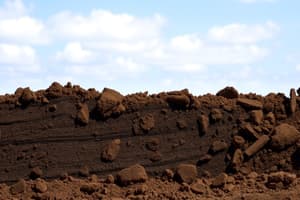Podcast
Questions and Answers
What does the 1st letter in the Unified Soil Classification System (USCS) represent?
What does the 1st letter in the Unified Soil Classification System (USCS) represent?
- Type of soil
- Soil moisture content
- Dominant grain size (correct)
- Soil color
What does the 1st letter G stand for?
What does the 1st letter G stand for?
gravel
What does the 1st letter S stand for?
What does the 1st letter S stand for?
sand
What does the 1st letter M stand for?
What does the 1st letter M stand for?
What does the 1st letter C stand for?
What does the 1st letter C stand for?
What does the 1st letter O stand for?
What does the 1st letter O stand for?
What does the 2nd letter in the USCS mean for coarse-grained soils?
What does the 2nd letter in the USCS mean for coarse-grained soils?
Define graded in the context of soil.
Define graded in the context of soil.
Which grain sizes are considered coarse?
Which grain sizes are considered coarse?
What does the 2nd letter C indicate?
What does the 2nd letter C indicate?
What does the 2nd letter M refer to?
What does the 2nd letter M refer to?
What does the 2nd letter W stand for?
What does the 2nd letter W stand for?
What does the 2nd letter P represent?
What does the 2nd letter P represent?
What does the 2nd letter mean for fine-grained soils?
What does the 2nd letter mean for fine-grained soils?
Which of the following are considered fine-grained soils?
Which of the following are considered fine-grained soils?
What does the 2nd letter H indicate?
What does the 2nd letter H indicate?
What does the 2nd letter L refer to?
What does the 2nd letter L refer to?
Define Atterberg limits.
Define Atterberg limits.
Define shrinkage limit.
Define shrinkage limit.
Define plastic limit.
Define plastic limit.
Define liquid limit.
Define liquid limit.
Define plasticity index and equation.
Define plasticity index and equation.
When is the plasticity index (PI) considered high and for what types of soils?
When is the plasticity index (PI) considered high and for what types of soils?
When is the plasticity index (PI) considered low and for what types of soils?
When is the plasticity index (PI) considered low and for what types of soils?
Study Notes
Unified Soil Classification System (USCS) Overview
- USCS categorizes soils based on grain size, plasticity, and other characteristics.
- Designations are represented using letters to indicate soil types and properties.
Soil Types by Dominant Grain Size
- G: Gravel, a coarse-grained soil.
- S: Sand, another type of coarse-grained soil.
- M: Silt, classified as fine-grained soil.
- C: Clay, also a fine-grained soil.
- O: Organic-rich soils, indicating high organic material content.
Grading and Sorting
- Coarse-grained soils are assessed for grading quality.
- Well-graded indicates a variety of particle sizes, while poorly graded suggests uniformity.
- Grading terminology applies, where well-sorted implies a narrow size range.
Characteristics of Coarse-Grained Soils
- Coarse grain sizes include gravel (G) and sand (S).
- The second letter can denote grading quality:
- C for clayey coarse-grained soil.
- M for silty coarse-grained soil.
- W for well-graded clean sand/gravel.
- P for poorly graded clean sand/gravel.
Fine-Grained Soil Analysis
- Fine-grained soils include silt (M), clay (C), and organic-rich (O).
- Evaluated based on liquid limits:
- The second letter indicates if the soil has a high (H) or low (L) liquid limit.
Atterberg Limits
- Define plasticity and behavior of soils under varying moisture:
- Shrinkage Limit: Moisture level below which soil volume remains unchanged.
- Plastic Limit: Minimum moisture for soil to exhibit plastic behavior.
- Liquid Limit: Minimum moisture at which soil flows like a liquid.
- Plasticity Index (PI): Represents the moisture range where soil behaves plastically but not as a liquid.
- Formula: PI = Liquid Limit (LL) - Plastic Limit (PL).
PI Variations and Soil Types
- High PI (>50) correlates with clay soils characterized by significant plasticity.
- Low PI (<50) associated with silts, indicating lower plasticity levels.
Studying That Suits You
Use AI to generate personalized quizzes and flashcards to suit your learning preferences.
Description
Test your knowledge of the Unified Soil Classification System (USCS) with these flashcards. Each card presents a letter and its corresponding meaning related to soil properties. Perfect for students and professionals in geology and civil engineering.




